The SmartRunner Matcher uses the laser light section technology to capture height profiles and compares them with a taught reference profile. With up to 32 profiles stored in the sensor, it is perfect for positioning as well as presence and completeness checks of guided components.
The laser profile sensors are based on the unique SmartRunner technology. For the first time, this combines the proven laser light section technology with a 2-D vision sensor including LEDs and offers maximum performance in a compact sensor housing.
SmartRunner Matcher: The Specialist for Profile Matching
The SmartRunner Matcher combines application-specific profile detection with an integrated evaluation in a compact housing. The control unit of the laser profile sensor is optimized to detect deviations from a previously taught-in height profile.
First, a reference profile is taught in via an intuitive operating wizard. In addition, the permitted position and component deviations are defined. Based on this, the sensor verifies the detected profile of the object and its correct position via profile matching. Moreover, variants are available with further functions such as the use and storage of up to 32 profiles on one sensor and the output of the object position deviation. These offer different detection ranges of up to 700 mm distance as well as 300 mm X detection range.
The SmartRunner Matcher can be commissioned easily and intuitively: via the Vision Configurator—the uniform user interface for all vision sensors from Pepperl+Fuchs—via Data Matrix control code or via guided operation and parameterization with the software wizard.
Typical Applications
- Detection of small parts like screws, clamps, and studs
- Completeness check for battery cells, pens, pills, etc.
- Position check and output for boxes, pallets, and other objects
How It Works
This is how the detection of object contour, position and distance works with the Matcher:

Since not every object is the same, a suitable object tolerance must be defined. This is done by defining an envelope curve around a taught-in profile (1). Depending on this, quality values are automatically determined, from which quality threshold values can then be derived to distinguish between good and bad parts. Users can freely define how high the detection sensitivity of the sensor should be (2). Furthermore, displacement tolerances often result from trigger tolerances. With the Matcher, these can also be set in 0.1 mm steps in the X and Z directions so that they do not influence the measurement result (3). The SmartRunner then reliably detects deviating profiles as “Bad” (4).
Highlights
- Rugged and cost-effective presence, completeness, and position detection of components
- Precise profile matching, even with different surface structures, ambient light, and varying operating distances
- Independently adjustable object and offset tolerances and separate data output
Poniższe przykłady użycia pokazują wiele możliwych zastosowań czujnika SmartRunner Matcher:
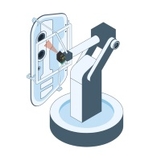
W przemyśle motoryzacyjnym nadwozia samochodowe są spawane z prefabrykowanych elementów blaszanych. Niekompletne i uszkodzone elementy należy wykryć i usunąć z produkcji. Czujnik SmartRunner Matcher wykorzystuje technologię triangulacji laserowej do wykrywania obiektów metodą porównywania profili i sprawdzania, czy elementy są kompletne…
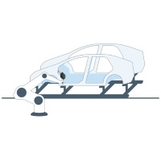
Podczas montażu ramy pojazdu komponenty są łączone za pomocą elementów złącznych, takich jak kołki, śruby i zaczepy. Czujnik SmartRunnner Matcher wykrywa, czy części te są obecne i czy znajdują się we właściwym miejscu, wysyłając sygnał do systemu sterowania, jeśli brakuje elementu złącznego…
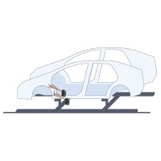
Aby ograniczyć hałas podczas jazdy, do różnych części ramy pojazdu mocowane są silikonowe tłumiki drgań. Aby zapewnić, że tłumiki znajdują się we właściwym położeniu, czujnik SmartRunner Matcher uczy się profilu każdego silikonowego tłumika drgań i profil wysokości wykrywany w danej chwili jest porównywany z profilem odniesienia…
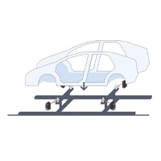
W produkcji samochodowej budowane nadwozie samochodu jest transportowane do różnych stacji przetwórczych na ramach transportowych typu „skid”. Śruby mocują nadwozie do ramy transportowej typu „skid” i są wciskane w otwory w nadwoziu. Aby zapewnić bezpieczeństwo tego procesu, czujnik SmartRunner najpierw sprawdza położenie śrub w ramie transportowej.
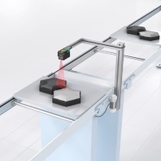
Systemy zrobotyzowane oraz systemy manipulacji materiałami są często używane do podawania przedmiotów poddawanych obróbce lub surowców do systemów produkcji i przetwarzania. Zanim robot odbierze podawane elementy, należy sprawdzić obecność nośnika obrabianego elementu (monitorowanie obecności) i położenie materiału (monitorowanie położenia). Czujnik SmartRunner Matcher wykonuje oba zadania wykrywania w jednym kroku.
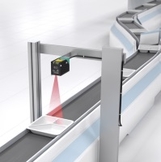
W przemyśle spożywczym do produkcji gotowych posiłków są często wykorzystywane plastikowe tace podzielone na kilka niewielkich przegródek. Aby zapewnić umieszczanie składników posiłku w odpowiednich przegródkach, należy sprawdzić wyrównanie monochromatycznych, białych tacek. Czujnik SmartRunner Matcher zapewnia jednoznaczne wyniki wykrywania nawet w trudnych warunkach otoczenia.







 +48 22 256 9770
+48 22 256 9770